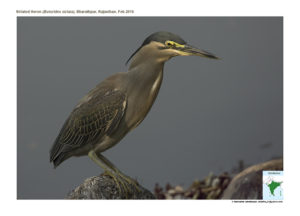Straited Heron

Striated Heron Butorides striata
Etymology:
- Butorides : Derived from genus Butor- bittern; oides resembling.
- Striata : Latin word striatus –striated
Vernacular names: Hindi: Kancha bagla, Ben: Kana bak, Kuro bak, Guj: Lili bagli, Lili bagali, Mar: Hirva bagla, Wak, Hiravi Dhokri Ta: Doshi kokku, Te: Dosi konga, Mal: Chinna kokku, Kan: Jaugu hakki, Sinh: Podi kokka, Mald: Rabonde, Rabulli
They are also known as mangrove heron, little heron or green-backed heron
Distribution in India: Wide spread resident except for Himalayas and North
Description: Size of 35–48 cm; wt. of 125–260 g; wingspan of 52–60 cm. It has extensive variation in plumage, sometimes even within same race. The adults have a blue-grey back and wings, white underparts, a black cap; a dark line extends from the bill to under the eye and short yellow legs. Juveniles are browner above and streaked below. The races found in India are race spodiogaster (Andamans, Nicobars and islands) and race chloriceps (Indian Subcontinenet).
Habitat: It is found in wetland and waterbodies like tanks, lakes, streams, Mangroves and coastal lagoons.
Food Habits: It usually feeds at the edge of ponds but make extensive use of floating vegetation such as water hyacinth to access deeper water. It may also on occasion swim on water or fish from the air and land in deeper waters. It flies low over water to drive frogs and fishes towards the shore before settling along the shoreline. It has been noted to pick up bait like bread, dead insects etc. and drop them on the water surface to bait fishes. It eats small fish, crustaceans, frogs, aquatic insects. During the day it rests in trees or bushes
Breeding Habits: The breeding season begins with the onset of the monsoons. They nest in a platform of sticks. It is usually built in not too high off the ground in shrubs or trees but sometimes in sheltered locations on the ground, and often near water. The male usually collects the material while the female constructs the nest. The clutch is of 3-5 eggs.The eggs are normally laid at two-day intervals and incubation usually starts after the first or second egg has been laid. Both birds take part in incubation and the period lasts for about 25 days. Both parents feed the young. The young fledge at about 5 weeks and become independent at 8 weeks.